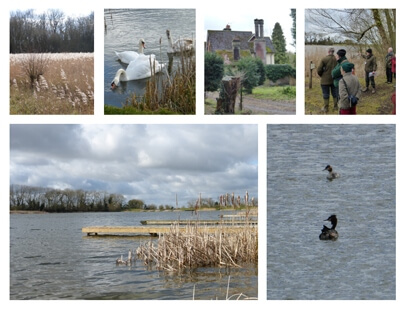Weston Turville Reservoir

The reservoir is about 0.5 miles south of Weston Turville on the lane towards Wendover. It was created in 1797/8 to compensate the mill-owners who were left high and dry when the Wendover Arm of the Grand Union Canal took the water on which their machinery depended. As a practical proposition it had a limited life, but as a leisure resource it’s the gift that keeps on giving.
Perhaps inevitably, the Rothschilds acquired it and made it a watery outpost for the revels they staged place at Halton House. As part of that estate it passed 100yrs ago into the RAF’s hands and hence the nation’s. Today it is managed by the BBOWT as a nature reserve, and it shares its facilities with anglers and yachtsmen. It has some very distinctive features and is well worth a visit.
The first notable advantage is the plentiful free parking in a lay-by on World’s End Lane. Then there are well-finished paths around two sides of the reservoir, and hence the opportunity easily to examine various different habitats: wetland, reed-beds and woodland. The focal point is a hide, which happens to be close to the reserve’s main claim to floral fame: at least 500 spring-flowering early marsh orchids. According to a book called Rothschild’s Reserves, by Miriam Rothschild and Peter Marren, the Society for the Promotion of Nature Reserves considered leasing the reservoir, but it decided that the War Office’s stewardship was sufficient protection.
It has been a nature reserve since 1966 and is a scheduled SSSI, ‘but rather a borderline one’, according to Rothschild and Marren. They describe it as ‘a pleasant lake of 5ha or so’, adding that the water is not of high quality. BBOWT volunteer Steve Hawkins alluded to this in one of the talks that punctuated his tour: the BBOWT tries to maintain a balance, particularly in the shallows and reedbeds, to help nature support the species that live there. He noted with satisfaction that some species were helping themselves: reed buntings, for example, have been noticed paying regular visits to a nearby field of rape.
Other notable residents include a bittern, one of only 100 booming males in the UK. ‘In 1997 the UK population was down to 11 (booming males) because reed-beds across the country were drying out,’ says Steve. There are also water rail, which feed happily if discreetly close to the hide (this is their only regular breeding site in Buckinghamshire); reed warblers as well as buntings; and a wide variety of waterfowl here and on the nearby Wendover Arm. In summer, bats, dragonflies and damselflies take wing too.
In fact there is interest almost everywhere you look. It is a historic site, a little gem and it’s on our doorstep.

